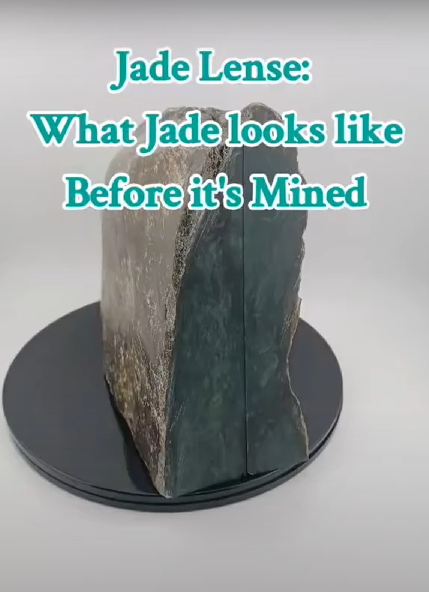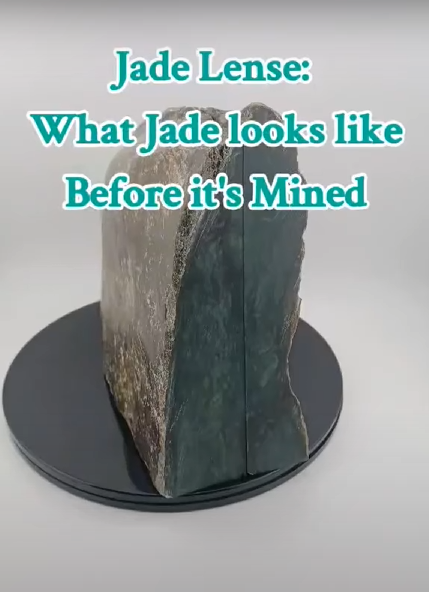
What are Jade Lenses? Nature’s Hidden Masterpieces
Translucency Jade Jewelry分享
Unveiling Jade Lenses: Nature’s Hidden Masterpieces
When most people picture jade, they imagine a glossy green stone gleaming in jewelry or carvings. However, before this transformation, jade looks completely different in its natural state. Found as jade lenses embedded in rock, these raw formations are often mistaken for ordinary stones. In this article, we’ll dive into what jade looks like in its untouched form, why weathering disguises it, and how its hidden beauty is revealed through careful craftsmanship.
1. What Are Jade Lenses?
Jade lenses are natural deposits of jade that form deep within the Earth’s crust under immense heat and pressure. They typically develop within metamorphic rocks, such as serpentine, and are shaped like elongated or oval “lenses,” hence the name. Both nephrite and jadeite, the two main types of jade, are found in this form.
While polished jade is revered for its vibrant colors and smooth texture, jade lenses in their raw state are far less glamorous. They are often encased in dull, weathered material that conceals their brilliance. Beneath this rough exterior lies a gemstone with rich cultural and historical significance.
2. Jade’s Natural Appearance Before Mining
In its unprocessed form, jade is encased in layers of host rock and weathered material. These outer layers, known as “weathering skin,” are typically rough, dull, and unremarkable. The true gemstone is hidden beneath this layer, requiring skilled hands and tools to extract its beauty.
Nephrite jade, known for its fibrous and waxy texture, often appears as a muted green or creamy white stone in its raw state. Jadeite, on the other hand, has a more granular structure and may show hints of brighter greens or even lavender when exposed. Without polishing, however, both types of jade remain subdued, blending into their rocky surroundings.
3. How Weathering Alters Jade Lenses
Weathering is the natural process of exposure to environmental elements like water, air, and temperature changes. Over time, this process can significantly alter the appearance of jade lenses, making them look like ordinary rocks. Here’s how it happens:
a. Oxidation and Surface Stains
Minerals such as iron and manganese in the surrounding rock oxidize when exposed to air, creating reddish, brown, or yellowish stains. These oxidized layers mask the vibrant hues of the jade underneath.
b. Chemical Leaching
Acidic rain or groundwater can leach minerals from the outer layers of jade lenses. This process creates a porous and weathered surface, further camouflaging the jade.
c. Physical Erosion
Wind, rain, and other physical forces gradually wear down the surface of jade lenses. This erosion smooths their edges and makes them harder to distinguish from other rocks.
d. Formation of Weathering Skin
Over time, a dense outer layer forms on the jade lens, composed of oxidized material and clays. This weathering skin often completely conceals the vibrant stone within.
4. Why Do Jade Lenses Look Like Regular Rocks?
Several factors make jade lenses blend into their natural surroundings:
- Host Rock Camouflage: Jade lenses are embedded within host rocks, which makes their boundaries less distinct. Without cutting into the stone, it’s difficult to recognize jade.
- Weathering Effects: Oxidation, erosion, and leaching mask the jade’s true nature, creating a rough, rocky exterior.
- Lack of Polish: Natural jade lacks the polished finish that highlights its vibrant colors, leaving it dull and unremarkable.
Even experienced geologists sometimes struggle to identify jade lenses without specialized tools and techniques.
5. Revealing the Hidden Treasure
Uncovering jade lenses requires patience and expertise. Miners often rely on exploratory cuts to reveal the stone’s interior. Once the weathering skin is removed, the jade inside is exposed, displaying its stunning range of colors and textures.
Interestingly, some collectors and artisans value the natural weathered skin of jade lenses. Known as “jade patina,” this outer layer tells the story of the stone’s journey through time, adding character to the finished piece.
6. Appreciating Jade’s Natural Journey
Jade lenses remind us that beauty often lies beneath the surface. To the untrained eye, they may appear as ordinary rocks, but their true value is revealed through careful craftsmanship. The process of transforming raw jade into dazzling jewelry or sculptures is a testament to both nature’s artistry and human ingenuity.
- Jade The Jade Carver



